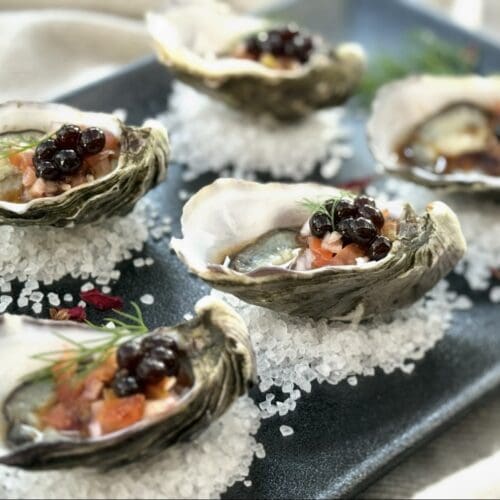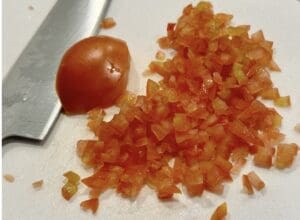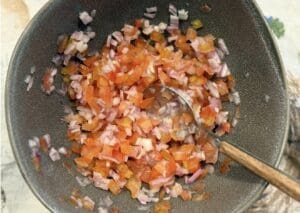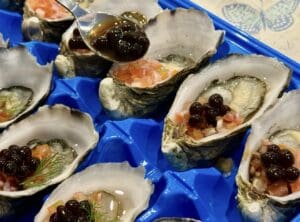
Oysters with Balsamic Pearls
Oysters with Balsamic Pearls is a new and exciting way to enjoy oysters. Bursting with flavour from the pearls, lemon, shallots and tomatoes!
Video
Ingredients
- 12 large oysters, shucked on their half shell (NOTE 1)
- ¼ cup (40g / 1.4oz) finely diced tomatoes
- ¼ cup Sticky balsamic pearls (NOTE 2)
- 2 tbsp (20g / 0.7oz) finely diced shallots or eschalots (NOTE 3)
- 2 tsp (10ml / 0.3floz) lemon juice
- ⅛ tsp of fine salt
Optional garnish and presentation
- fresh dill
- coarse salt to stand the oysters on
Instructions
- To ensure optimal flavour and texture, serve these oysters immediately after preparing them. Remove any liquid from the oysters. Cut the tomato in half and discard (or keep for other use) the pulp and seeds. Pat the insides of the tomato with paper towels, then finely dice them. You will need 1/4 cup, or 40g / 1.4oz of diced tomatoes.

- Put the tomatoes, shallots, lemon juice, and salt in a bowl, then mix to combine. .

- Spoon on a teaspoon of the tomato and shallot mix on each oyster, then top them with a teaspoon of balsamic pearls. Garnish with a small dill sprig if desired, then use coarse salt to arrange the oysters on the plate. Serve and enjoy right away!

Notes
(NOTE 1) Oysters - For this recipe, you'll need 12 large fresh shucked oysters resting on their half shell. Over here, the oysters are already cleaned and opened before they're sold. If they're closed where you are, see if your fishmonger to shuck your oysters.
(NOTE 2) Balsamic pearls are small balls filled with liquid balsamic. They create a burst of intense flavour when eaten. Sticky Balsamic (not sponsored) gifted me a jar of their pearls. Sweet, tangy, and tantalisingly delicious, with a burst of balsamic flavour. If you can't find balsamic pearls, a drizzle of high-quality balsamic vinegar or glaze will add a lovely tangy sweetness to the oysters.
(NOTE 3) Shallots (eschalot or French shallots) - Shallots look like small brown onions but are skinny and oval-shaped with a mild flavour. They're difficult to peel and are usually more expensive than other types of onions. You could swap shallots for equal amounts of brown or red onion.
I've used a third-party application to calculate the calories and nutritional information, so please use this as an approximate guide only.
Cooking measurements are in Australian standard spoon and cup measurements. For specific details and conversions, visit our Australian Cooking Measurements page.
I would love your feedback and support if you made this recipe. To do this, please rate this recipe and provide a comment by scrolling down this page or by clicking that green circle on the bottom left. An email address is required (for spam), but it won’t be published. I would also love to see your dish, so don't forget to tag me on my Instagram account '3catsfoodie'
Cheers – Cat T
Nutrition
Serving: 1 ServingCalories: 31kcalCarbohydrates: 2gProtein: 0.2gFat: 0.03gSaturated Fat: 0.01gPolyunsaturated Fat: 0.01gMonounsaturated Fat: 0.004gTrans Fat: 0.001gCholesterol: 1mgSodium: 26mgPotassium: 17mgFiber: 0.1gSugar: 1gVitamin A: 29IUVitamin C: 1mgCalcium: 2mgIron: 0.1mg